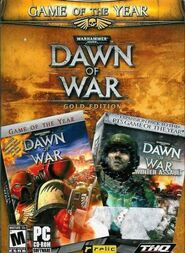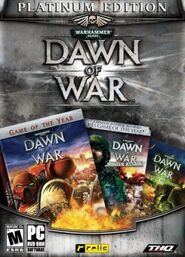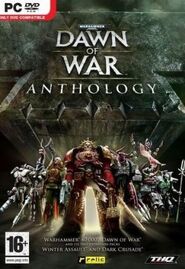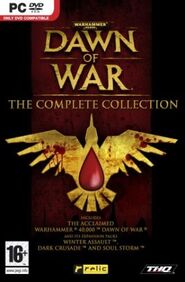| This article contains generic information about the title. For in-game statistics, walkthroughs and such, please visit our Dawn of War portal. |
Warhammer 40,000: Dawn of War is a military science fiction real-time strategy video game developed by Relic Entertainment and released by THQ on September 20, 2004. Afterwards, there have been three expansions: Winter Assault in 2005, Dark Crusade in 2006 and Soulstorm in 2008. The sequel, Dawn of War II, was released in 2009.
Dawn of War is based on the popular tabletop miniature wargame Warhammer 40,000, developed by Games Workshop and originally published in 1987.
Gameplay[]
Dawn of War is a small-scale RTS game where the player commands infantry squads and ground vehicles to defeat his opponent(s). Combat units are produced from production buildings using two resources: Requisition and Power. The Requisition resource is gathered by controlling "Strategic Points" on the combat map; these points must be "captured" by an infantry squad and can be taken back by the opponent. The Power resource is gathered by building generator structures, which require Requisition to be built.
The combat units engage in both ranged and close combat to defeat enemy units. Many units have specific roles; e.g., a lightly armed infantry squad may be effective against other infantry but useless if trying to shoot at an armored transport vehicle, while a missile launcher would damage the transport vehicle badly yet remain ineffective against infantry squads. Units may have special abilities such as concealment, throwing grenades or teleporting short distances.
The game is usually won by either destroying the opponent's base or controlling a majority of the strategic assets on the map. Single-player campaign missions may also involve destroying a specific character.
Factions[]
Dawn of War features four fully playable factions from the Warhammer 40,000 universe: the Space Marines, Orks, Eldar and the Chaos Space Marines. The player can also control a very limited selection of Imperial Guard units in certain single-player campaign missions.
Modes[]
The game has a linear single-player campaign that spans a total of 11 missions, and a multiplayer mode that allows individual or teamed matches for up to eight players. In the single-player campaign, the player must control the Space Marines faction, while multiplayer mode allows choosing Orks, Eldar or Chaos Space Marines as well.
Plot[]
The Single player campaign is set on the planet Tartarus, an Imperial planet that is currently being besieged by a large Ork invasion force. The campaign begins with Colonel Brom and his 37th Tartarus Planetary Defense Force Regiment under attack by a large group of Orks. The Blood Ravens 3rd company, led by Captain Gabriel Angelos arrive on the planet and saves Brom and his remaining men, who then proceed to exterminate the remaining Orks in the vicinity. In the aftermath of the battle, Gabriel is joined by the Librarian Isador Akios. Brom asks Isador about the recent sterilization of the planet Cyrene; however Isador makes it clear he is not to bring it up again, particularly not in Angelos's presence. The Blood Ravens then prepare to attack the Orks surrounding the port, in order to protect the evacuation craft.
Isador, sensing that the Captain's mind is troubled, realises why, and tells him that there was nothing he could have done to save his home planet of Cyrene. However, Gabriel tells him not to mention it again, stating that his homeworld was his responsibility. After the extermination of the Orks, scouts reveal to Gabriel that Chaos forces are operating on the planet. Soon after this they are joined by an Inquisitor Mordecai Toth, who orders them to leave the planet, warning that a Warp Storm is approaching the planet and will consume the planet in 3 days time. Toth orders a complete evacuation of the planet, but Gabriel refuses, stating his desire to investigate the possible threat of Chaos. Toth then implies that Gabriel's actions on Cyrene have clouded his judgement, making him "see Chaos where it doesn't exist". On further investigation, it is revealed that the Eldar are also operating on the planet. The Blood Ravens find an altar dedicated to Chaos, confirming Gabriel's suspicions, and resolve to destroy the traitors, unknowing that Isador is already under the influence of Sindri Myr, the Chaos Sorcerer of the Alpha Legion.
The Blood Ravens pursue the Eldar to the abandoned city of Loovre Marr and engage them in a full-scale battle across the city. Upon the destruction of most of the remaining Eldar by Gabriel's forces, their leader, Farseer Macha pleads with Gabriel to heed her words; however during their moment of distraction, Sindri steals an artifact, which Macha reveals to be a key to "the undoing of this world". When Gabriel tries to inquire for more information, the Farseer shows surprise at his ignorance, commenting that the Inquisitor "keeps them on a short leash". Macha implies that Toth knows more than he is telling, and advises Gabriel and Isador to ask him, before telling the Blood Ravens where to find the entrenched Chaos forces, stating that thanks to the Space Marines, the Eldar are too weak to confront them.
After a pitched battle with the forces of the Alpha Legion (including traitorous Imperial Guard regiments who have been corrupted by Chaos) Gabriel and Isador confront Toth in the ruins of an Imperial Temple. He reveals that the world is cursed, and bears an artifact of Chaos: the Maledictum, a stone that contains the essence of a daemon. The forces of Chaos now bear all that they need to unearth it. Toth also explains that the Eldar were fighting to protect the stone, as it was they who imprisoned the daemon in the stone originally. Toth comments that "as Chaos's oldest enemy, the Eldar see themselves as the only capable defence against its influence. And we have paid for their arrogance". Toth also says that the power of the Maledictum is enough "to turn the faithful and drive men mad", having already corrupted much of the population of Tartarus and the Imperial Guard, as well as affecting the Blood Ravens somewhat: Toth explains his insistence the Blood Ravens depart was to protect them from being trapped on the planet with the demon by the coming Warp Storm. Gabriel and Toth form an alliance and make plans to find and destroy the Maledictum.
However, Isador is completely overcome by the temptations of Sindri and Chaos, and resolves to steal the Maledictum for himself. While the Blood Ravens and the remaining loyal guardsmen are busy exterminating the army of Lord Bale, Isador seizes his chance and steals the Maledictum. Inquisitor Toth then reveals that he had known that Chaos was corrupting one of the Space Marine commanders, but he had suspected Gabriel and they had paid the price for his error. In the face of Isador's betrayal, Gabriel pursues him in an effort to bring him to justice. The Blood Raven forces are successful in destroying Isador’s troops and Gabriel challenges Isador to a duel. Isador holds the upper hand at first, taunting Gabriel about his weakness and guilt over what he did to Cyrene, but Gabriel finally lets go of his guilt, replying that he did the right thing to stop the taint on Cyrene spreading further; goaded to fight back, Gabriel eventually defeats Isador. Beaten, Isador pleads Gabriel for forgiveness and a chance to redeem himself. Gabriel tells him, "If redemption is what you seek, then that is what I will give you" before shooting him in the head with his bolt pistol, using him as an example to his men about the dangers of Chaos.
Meanwhile Sindri had attempted to use the power of the Maledictum for his own ends, transforming himself into a Daemon Prince with the stone's power. Inquisitor Toth bequeaths the Daemon Hammer, God-Splitter, to Gabriel since he feels that it is Gabriel that will end this battle and not him. They then, with the Blood Ravens and the aid of the remaining Eldar forces of Farseer Macha, attack the Chaos forces, eventually killing Sindri. The final scene sees the Eldar and Blood Ravens standing around the Maledictum. Despite the warnings of Farseer Macha, who begs them not to destroy the stone, Gabriel obeys Inquisitor Toth and his own judgement, and destroys the Maledictum with God-Splitter. The Eldar forces then retreat after Macha prophetically warns Gabriel that he has doomed them all. Inquisitor Toth and the Blood Ravens leave to be evacuated. However, Gabriel stays behind, and encounters the Daemon of Khorne which he unwittingly released from the Maledictum. The daemon lets Gabriel and his men leave safely as thanks for its release, but not before informing Gabriel that the planet was actually an altar to the blood god, Khorne. In fact, the Ork invasion had been prearranged by Sindri, who sought the release of the Daemon of Khorne through the spilling of blood upon the planet. Every death had been a sacrifice toward the daemon's release, in which Gabriel's contributions were "many and magnificent". The daemon acknowledges that if he had been released much earlier, he would have been much easier to destroy. The daemon then tells Gabriel to flee, and to know that soon he would come to claim them all. Gabriel then vows to destroy the daemon, before following after his departing men.
Reception[]
Reviews for Dawn of War were mostly positive, adding up to a Metascore of 86 (out of 100) on Metacritic with most of the reviews in the excellent range. Gameplay was considered conservative but top-notch, although there were some complaints about the campaign being too simplistic. Graphics and audio were praised; they actually hold pretty well even today, five years later. As GameSpy put it, "While Dawn of War doesn't break any new ground for the RTS genre, it is, nonetheless, a supremely polished and well-balanced example of it, a credit to both the development team, and a laurel wreath for the license it bears."
- Metacritic: 86 (out of 100) [1]
- IGN: 8.8 (out of 10) [2]
- GameSpy: 4.5 (out of 5) [3]
- GameSpot: 8.8 (out of 10) [4]
- 1UP: A [5]
Details[]
- Developer: Relic Entertainment
- Publisher: THQ
- Release date: September 20, 2004
- System: PC
- Genre: Real-time strategy
- Players: 1–8
- Current version: 1.51 (patch downloads)
- Website: Warhammer 40,000: Dawn of War
Special editions[]
- Game of the Year (Dawn of War & four exclusive maps): September 21, 2005
- Gold Edition (Dawn of War & Winter Assault): March 31, 2006
- Platinum Edition (Dawn of War, Winter Assault & Dark Crusade): November 2006
- Dawn of War: Anthology (Dawn of War, Winter Assault & Dark Crusade): 2006
- Dawn of War: The Complete Collection (Dawn of War, Winter Assault, Dark Crusade & Soulstorm): March 2008








